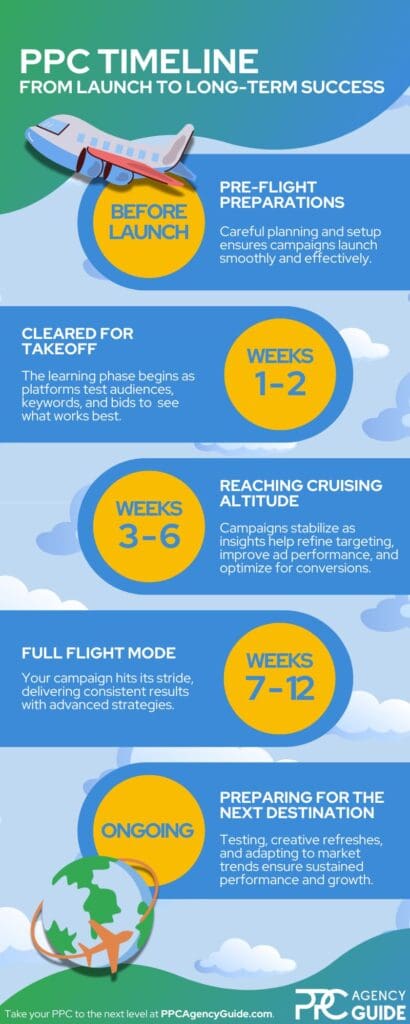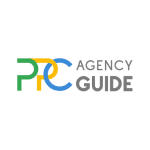
“Reach customers wherever they are,” the Google Ads homepage promises. “Show up at the right time and place across the vast Google Ads ecosystem.” It sounds simple, like you just need to tick a few boxes, and the sales will start pouring in. But here’s the thing: your pay-per-click (PPC) impact over time will change, and it may be a while before your campaigns actually take off. In this guide, we’ll cover why you won’t see results right away, what happens in the early stages of a PPC campaign, and what a typical PPC performance timeline looks like.
Pre-Flight Preparations: Building the Foundation for PPC Success
When you first sign with a PPC agency or hire an advertising professional to run ads for you, it’s likely the culmination of a long journey for you. You’ve built a business and developed a PPC budget, and now you’re ready to get things moving before the ink dries on your contract. However, this is just the start for your advertising professional. There’s a lot of prep work that must be done before your campaigns can be launched. Depending on the complexity of your brand and ads, expect to give your ad management team two or three weeks to complete foundational activities, such as those outlined below.
Learning Your Business and Market
Your advertising team dives deep into your industry, competitors, and audience to ensure the ads resonate. They use this information to ensure the campaign aligns with your unique needs.
Identifying PPC Success Metrics and Setting PPC Goals
Are you trying to build your brand, generate leads, get immediate sales, or something else? Your team will match PPC goals to your business goals and identify the best metrics to gauge success.
Crafting the Right Messaging and Creative Assets
Ads must be compelling to grab attention, but they also need to match your brand’s voice and goals. Your team is refining copy and visuals to make the strongest first impression on your audience.
Mapping Out Targeting and Keywords
Behind every ad is a carefully crafted strategy. Your team is researching keywords your audience is searching for and building audience profiles to make sure the ads are seen by the right people at the right time.
Ensuring Seamless User Experiences
Once someone clicks an ad, what happens next matters just as much. Your team is testing landing pages to make sure they align with the ad’s message and are optimized for conversions.
Cleared for Takeoff: The First 1-2 Weeks
Once your PPC campaigns go live, you’ve officially entered the learning phase. This is where platforms like Google Ads or Meta Ads begin collecting data and testing various strategies to figure out the most effective way to achieve your campaign goals. It’s an exciting milestone, but it’s also a time when results can feel inconsistent—and that’s completely normal.
What’s Happening During the PPC Learning Phase
- Data Collection Begins: The system starts learning how users interact with your ads—who’s clicking, when they’re engaging, and whether they’re converting.
- Testing Audiences and Placements: Platforms experiment with different audience segments, ad placements, and times of day to determine what works best.
- Bid Optimization: Your agency monitors and adjusts bidding strategies to ensure your ads are competitive without overspending.
Think of this phase like an airplane taxiing on the runway. The campaign is moving, but it hasn’t quite reached full speed yet.
Why Results Are Inconsistent
During the learning phase, the platform is trying to find its footing. It may overserve ads to less relevant audiences or struggle to predict what will lead to conversions. This is part of the trial-and-error process that’s necessary for building long-term success.
It’s common to see fluctuations in metrics like:
- Click-Through Rates (CTR): Audiences are being tested, so some may engage more than others.
- Cost per Click (CPC): Initial bidding might be higher as the platform adjusts to competition.
- Conversion Rates: These are usually lower in the first two weeks as the system learns which users are most likely to convert.
What You Should Expect
Your agency will likely spend the first one to two weeks closely monitoring performance and making small adjustments based on early data. These optimizations lay the groundwork for the next stage, where results begin to stabilize and improve.
Many agencies are good about managing PPC client expectations during this stage and will proactively warn them not to expect instant results, so don’t be surprised if you’re asked to reserve judgment on the success of your campaign for some time.
While it can be tempting to expect instant results, it’s important to remember that this phase is about building momentum. Allowing the system time to gather insights ensures stronger performance as the campaign progresses.
Reaching Cruising Altitude: Weeks 3-6
By now, your campaign has gathered enough data to start making smarter, more informed decisions. This is the stage where results begin to stabilize, and your agency can move beyond early testing to focus on refining and optimizing PPC over time. It’s not full speed yet, but your campaign is starting to find its rhythm. Think of it as reaching cruising altitude on a flight.
What’s Happening During the Early Optimization Phase
- Refining Audience Targeting: By analyzing the data from the learning phase, your agency identifies which audience segments are engaging and converting. They’ll narrow targeting to focus on high-performing groups while eliminating wasted spend on less effective ones.
- Optimizing Ad Performance: Early tests have revealed which headlines, images, and calls-to-action resonate most with your audience. Your ads are now more tailored and relevant, increasing their effectiveness.
- Adjusting Budgets and Bids: With clearer insights into what’s working, your agency reallocates budget to top-performing ads and optimizes bids to maximize return without overpaying.
- Improving Conversion Paths: If landing pages or forms are underperforming, this is the time to tweak them—whether it’s streamlining the layout, improving messaging, or simplifying the user journey.
What Results Look Like Now
At this stage, you’ll likely notice steady improvements in key metrics:
- CTR: Ads are more refined and being shown to the right people, so engagement increases.
- CPC: The platform has learned which bids win placements without overspending, bringing costs down.
- Conversions: Whether it’s leads or purchases, conversion rates begin to climb as ads are shown to the most relevant audience.
However, it’s still early in the process. Your campaign is stabilizing, but it hasn’t yet reached its full potential.
Why This Phase Matters
This stage is where your campaign really starts to deliver actionable insights. Your agency uses these learnings to fine-tune the campaign and prepare it for long-term growth. Skipping over or rushing through this stage can leave untapped potential on the table, reducing your campaign’s overall ROI.
While you may start seeing some wins during this period, it’s important to remember that PPC is a process. With the right adjustments now, your campaign will be ready to hit its stride in the coming weeks.
Full Flight Mode: Weeks 7-12
Nearing the end of your second month, your PPC campaign is hitting its stride. At this stage, the foundation is solid, the platform has collected enough data to optimize delivery, and your ads are performing with greater consistency. Think of this as being at full flight. Your campaign is now cruising smoothly and delivering the results you’ve been waiting for.

What’s Happening During This Phase
- Maximizing High Performers: Your agency identifies which ads, keywords, and audiences are driving the best results and shifts more budget toward these high-performing elements.
- Scaling Campaigns: With a clear understanding of what works, this is the time to expand your efforts. Your agency might increase budgets, test additional keywords, or launch new ad variations to maximize growth.
- Fine-Tuning Bids and Placements: Now that the campaign is stable, your agency can focus on maximizing efficiency—adjusting bids for the best return on investment (ROI) and refining placements to reach users in the right context.
- Retargeting and Lookalike Audiences: This phase often introduces advanced strategies, like showing ads to people who have already engaged with your site (retargeting) or creating lookalike audiences to scale successful targeting.
What Results Look Like Now
At this stage, you should see noticeable improvements in performance metrics across the board:
- Higher Conversion Rates: Ads are now reaching the right audience, and landing pages are optimized to drive action.
- Better CPA: Your agency has optimized campaigns to reduce the cost of each conversion, increasing profitability.
- Improved ROI: With everything running more efficiently, the campaign is starting to deliver the kind of returns that justify your investment.
This is also when you’ll see more consistent performance. While there may still be occasional fluctuations, your campaign has settled into a steady rhythm.
Why This Phase Matters
This is where the work from earlier stages pays off. By now, your campaign isn’t just breaking even. It’s likely generating strong returns. The insights gained during the first few weeks allow your agency to refine and scale, setting the stage for continued growth.
However, this doesn’t mean it’s time to coast. PPC campaigns require ongoing attention to maintain performance. Your agency will continue monitoring trends, testing new ideas, and adapting to changes in your market to keep results strong.
Preparing for the Next Destination: Ongoing Optimization
Even when your PPC campaign reaches full flight mode, the journey isn’t over. Digital advertising is a constantly shifting landscape, and staying ahead requires continuous fine-tuning. Think of this stage as charting the course for your next destination, be it scaling your campaigns, exploring new strategies, or adapting to market changes.
What’s Happening During Ongoing Optimization
- Monitoring Performance Trends: Your agency keeps a close eye on campaign metrics to ensure they stay strong. If conversion rates dip or costs creep up, adjustments are made quickly to address the issue.
- Refreshing Ad Creative: Over time, even the best-performing ads can grow stale. New visuals, updated messaging, or seasonal promotions keep campaigns fresh and engaging for your audience.
- Expanding Audience Targeting: After locking in your core audience, your agency may start testing new segments or using tools like lookalike audiences to scale your reach.
- Retargeting Past Visitors: Retargeting campaigns focus on re-engaging users who have already interacted with your website or ads, giving them a gentle nudge to take the next step.
- Exploring New Opportunities: Whether it’s testing new ad formats, running campaigns on additional platforms, or capitalizing on industry trends, your agency is always looking for ways to grow your results.
Why Ongoing Optimization Matters
Even the most successful campaigns can falter if left unattended. Consumer behavior, market conditions, and platform algorithms are always evolving, which means your strategy needs to evolve, too.
Ongoing optimization ensures:
- Sustained ROI: Regular adjustments help keep costs down and results strong.
- Adaptability: Seasonal shifts or new competitors won’t catch you off guard because your campaign is always being monitored and adjusted.
- Growth Potential: Scaling efforts and new strategies can open up opportunities you hadn’t considered before.
What You Should Expect from This Stage
At this point, your campaign is no longer about “fixing” issues. It’s about maintaining momentum and maximizing growth. Your agency will work on:
- Regular Reporting: Keeps you informed of what’s working and what adjustments are being made.
- Proactive Recommendations: Suggests opportunities for scaling, testing, or shifting strategies to maximize growth.
- Consistent Results: Ensures your campaigns continue to align with your business goals and deliver the ROI you expect.
Develop Your Long-Term PPC Strategy with a Pro
The best PPC agencies don’t just build campaigns. They build relationships with their clients and the people they serve. That means it takes a little longer to get your first campaign off the ground, but it goes a long way toward ensuring the success of that campaign and each one that comes after. If you’re ready to work with an agency that puts in the time to do things right, request a complimentary consultation.

FAQs on PPC Impact Over Time
What are some of the early factors influencing PPC results?
Early results are impacted by factors like audience targeting, keyword selection, ad quality, and competition. Platforms test these elements during the learning phase to identify what works best for your campaign, leading to early fluctuations before results stabilize.
How does PPC success over time change?
PPC success evolves from inconsistent results during the learning phase to steady performance as data refines targeting and optimization. Over time, campaigns deliver higher ROI through advanced strategies like scaling, retargeting, and audience expansion.
Why does PPC take time to deliver results?
Platforms like Google Ads need time to gather data, test strategies, and optimize delivery. This trial-and-error process, known as the learning phase, ensures your ads target the right audience with the right message, leading to better long-term outcomes.
What happens during the PPC learning phase?
The platform tests audience segments, keywords, and ad placements to gather insights. Early results fluctuate as the system experiments to determine what drives your campaign’s goal—whether that’s clicks, leads, or sales. This phase typically lasts one to two weeks.
How long does it take for a PPC campaign to be profitable?
Most campaigns begin delivering consistent returns within two to three months, depending on factors like budget, competition, and goal complexity. Early stages focus on testing and refining, while long-term strategies maximize profitability.
What are the stages of a successful PPC campaign?
Successful PPC campaigns follow these stages: pre-launch planning, learning phase (weeks one to two), optimization (weeks three to six), and ongoing growth (six weeks and beyond). Each phase builds on the last, driving stronger results over time.
How can I tell if my PPC campaign is improving?
The improvement shows in key metrics like increased click-through rates (CTR), lower cost per click (CPC), and higher conversion rates. Look for trends in performance reports and consistent results as campaigns stabilize after the learning phase.
What should I expect from my PPC agency in the first three months?
Your agency will conduct research, set up campaigns, and monitor performance closely. Expect regular updates on learning phase progress, adjustments to targeting and bids, and early signs of optimization. Major improvements typically begin around month two.
Why do PPC metrics fluctuate early in a campaign?
Fluctuations are normal during the learning phase as platforms test different strategies. Metrics like CTR, CPC, and conversions vary until the platform identifies the most effective audience, placements, and messaging for your goals.


















